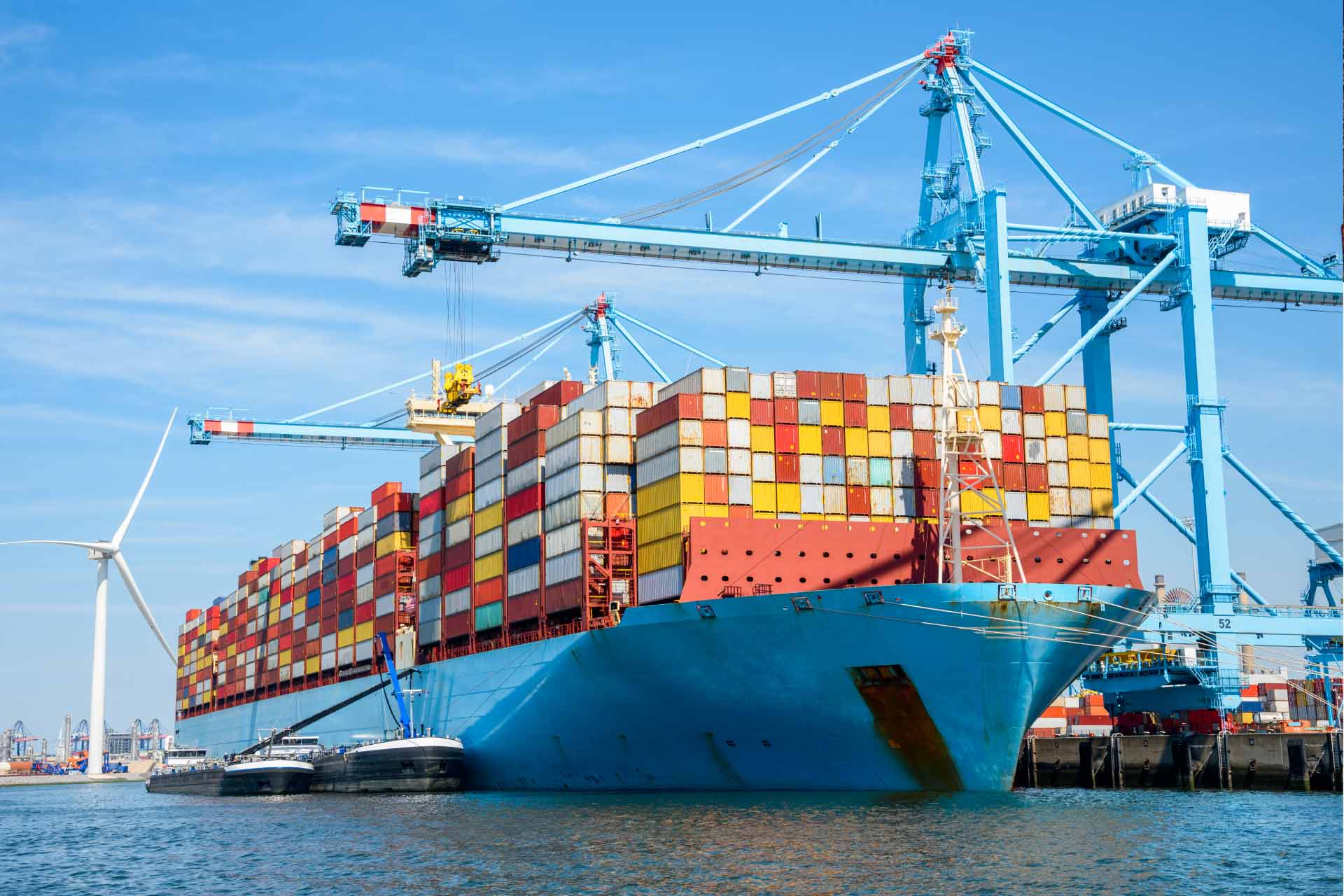
Professor Dongping Song proposes a time-phased roadmap to enable maritime transport decarbonisation, as part of a UK-wide research initiative to develop cleaner and more sustainable seaports.
Based on an analysis of relevant academic evidence and examples of sustainability strategies by some of the most important ports in the world, the roadmap describes the pathway to net zero in the sea transport sector.
The roadmap identifies six interconnected types of measures and shows how these develop across three consecutive stages characterised by increasing levels of port decarbonisation maturity.
The plan offers port-associated stakeholders1 guidelines to reduce emissions and provides a blueprint to transition to a cleaner energy future for other industries and local and national governments.
Dongping’s research is part of the UK National Clean Maritime Research Hub (UK-MaRes Hub), funded by the Engineering and Physical Sciences Research Council, the Department for Transport, and other associated universities and partners.
Decarbonising the maritime transport sector before 2050
The transport sector is one of the largest greenhouse gas (GHG) polluters globally, and accounts for nearly one third of UK emissions.
Maritime transport, as the backbone of world trade and globalisation, plays an indispensable role in achieving a sustainable global economy.
While shipping is generally a relatively carbon efficient mode of freight transport, maritime vessels represent around 5% of the UK’s domestic transport greenhouse emissions, more than rail and bus combined.
The International Maritime Organisation (IMO) set a series of ambitious targets to lower GHG emissions and reduce global warming.
This includes cutting carbon intensity (ie CO2 emissions) by at least 40% in 2030 and 70% by 2050, and lower overall GHG emissions to reach net zero2 by the same year (compared to 2008 levels).
Alongside this, individual countries have announced their own maritime decarbonisation goals.
In the UK, the Transport Decarbonisation Plan sets out commitments and actions to decarbonise the transport system, including maritime, to achieve net zero emissions by no later than 2050.
Seaports are part of complex shipping logistical networks where various types of vehicles and cargo handling equipment operate.
In addition to GHG emissions (mainly carbon dioxide and methane), seaports also produce health-impacting air pollutants, such as nitrogen oxides, sulphur oxides, particulate matter, volatile organic compounds and carbon monoxide.
While it is imperative to decarbonise port activities, achieving the ambitious national and IMO ‘course to zero’ targets requires an understanding of key technical and operational aspects, as well as barriers to accelerate sustainability in the maritime sector.
An UK-wide research hub to enable seaport decarbonisation
Th University is contributing to this effort by taking part in a new £21.3m multidisciplinary research partnership led by Durham University.
The UK-MaRes Hub brings together world-leading expertise and supports the sector to develop and commercialise clean maritime fuels and technologies.
The goal is to accelerate decarbonisation and eliminate air pollution from maritime activity in ports and at sea, through multidisciplinary research initiatives involving academics from 13 universities3.
It also brings together over 70 industrial, civic and international organisations, including shipping companies, ports, equipment and service providers, fuel producers and civic bodies.
Collaboration with University of Liverpool partners, Peel Ports Group, allows researchers to use the Port of Liverpool as a place-based scenario to showcase maritime decarbonisation.
As part of this project, Dongping is leading a pioneering investigation on port operations and infrastructure, and contributing to a parallel study on digitisation, maritime operations and finance.
A roadmap for net zero in the maritime sector
Following a comprehensive analysis of prior evidence and real-life port decarbonisation examples, Dongping presented a time-phased roadmap with strategic solutions to develop smart and greener ports in a 15-year period (2025-2040).
The three-stage pathway is based on a systematic review of academic literature, combined with industrial reports and case studies from some of the most important national and international ports4.
The case studies shed light on how seaports take steps towards net zero through six strategic types of measures: operational, technical, infrastructural, fuel and energy, digitalisation, and policy and collaboration.
The analysis highlights the need for a time-phased plan, that considers the specific role of different measures in the process to develop greener ports.
While operational, technical and fuel and energy measures have a direct impact on port emission reduction, the roadmap shows how their success relies on solid infrastructure, digitalisation and policy and collaboration solutions.
A roadmap of seaport decarbonisation to net zero with time-phased solution measures

Phase one: decarbonisation restricted by insufficient digitalisation and infrastructures
In phase one, resource optimisation is the focus of operational, technological, fuel/energy and infrastructural measures, with an emphasis on energy efficiency.
This includes upgrading existing equipment (eg LED lighting), phasing in power saving and clean energy options (eg solar panels, HVO-powered equipment5) and expanding rail service capacity to facilitate logistics efficiency and emissions reduction.
However, at this stage the unavailability of electrical power supply and infrastructure hinders the transition from fossil fuels to electricity for energy-intensive equipment.
In this phase, some digitalisation measures are present, including smart devices and sensors to collect real-time data and digitise information to enable data-driven optimisation.
However, stakeholders are largely working in silos due to reduced data visibility and the challenge of interoperability (ie the ability of computer systems and software to communicate).
Therefore, data standardisation (formats and platforms), should be addressed to overcome data incompatibility.
For policy and collaboration measures, relevant policies, regulations and financial incentives are necessary to accelerate port decarbonisation locally and globally.
Phase two: greener ports and increasing collaboration
In phase two it is expected port-associated stakeholders design mechanisms to share information and develop joint energy management systems.
Coordination across subsystems and stakeholders improves thanks to digitalisation measures, such as digital twins and tools, mobile satellite communication and the smart grid.
At this stage, infrastructural measures facilitate electrification and introduction of clean energy (eg hydrogen, solar, wind, wave and tidal) for energy-intensive equipment, such as gantry cranes.
Additionally, carbon capture and storage systems are rolled out alongside low-carbon fuel and shore power facilities to support sea vessel decarbonisation.
Stricter regulations and policies must come into force at this stage, and large-scale financial investment and support is needed to implement fuel and energy, and infrastructural measures.
Port operators are expected to collaborate with supply chain partners vertically, and with other ports horizontally, for better operations and energy management.
Phase three: ports as trading, energy and data hubs
Finally, in phase three it is expected more operational activities become integrated, automated and cooperatively optimised, with the support of digitalisation and collaboration.
Technically, small or short-distance vessels such as boats, tugs and ferries are powered by either battery or fuel cells, while large ships are likely to use alternative fuels or be equipped with a carbon capture storage system.
Scaling up green energy and fuel production is essential to meet huge demand from the maritime sector in this phase, with infrastructural improvements including renewable energy and hydrogen production, conversion, transport and storage facilities.
In addition, electric or solar roadways can be constructed to decarbonise road transportation.
Digitalisation goes one step further with the adoption of the smart port concept and AI-enabled data analytics (predictive and prescriptive) to improve efficiency and optimise energy consumption.
In terms of policy and collaboration measures, all organisations within the port geographic boundary would share the same net zero vision and work together as an ecosystem.
As ports are closely linked to the regional city, this stage requires collaboration between the port and the city, and cross-industry collaboration (eg steel, cement, and chemical industries) should be considered due to the ports’ potential to become energy hubs.
1 This includes carriers, shippers, port service providers, logistics operators, road, rail and barge operators, as well as port authorities and regulators.
2 Net zero refers to a balance situation in which the total amount of GHGs in the atmosphere is not increased by human activity.
3 The UK-MaRes Hub is a consortium led by Durham University with researchers from Aston, Birmingham, Brighton, City, Cranfield, Liverpool, Newcastle, Nottingham, Sheffield, Solent, St Andrews and Ulster universities.
4 The study includes an analysis of net zero strategies by the ports of Felixstowe, London. Immingham, Milford Haven, Liverpool, Southampton, Singapore, Los Angeles and Rotterdam.
5 HVO is a type of biofuel – also known as a renewable diesel – produced from waste vegetable oils and fats.
 |
Chair in Supply Chain Management |
|
You can read Ian and Dongpings's paper here: Song, D-P. (2024). 'A Literature Review of Seaport Decarbonisation: Solution Measures and Roadmap to Net Zero', Sustainability, 16(4):1620. |